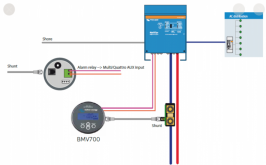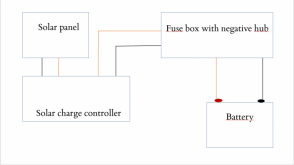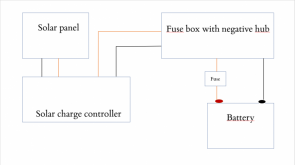For the summer of 2021 I plan to build small off grid irrigation system for tomatoes. The power source is a 12 v battery, and the main power consumer is a 75 W water pump. According to my calculations, the pump will pump six minutes week so it will suffice with a smaller battery just for the pump. But then I also have a timer, a relay (for extra watering with a push button if necessary) and maybe some small light, which draw current. Therefore I thought I should have a solar panel to charge the battery. The tomatoes will only grow in spring and summer, so it will be plenty of sun. I plan to have a 50 W panel and have a better charge controller (MPPT) if I want to extend the system in the future.
So far so good. However, there is a small problem with the wiring. Or not really a problem, but I wonder if I have missed something crucial. According to almost every wiring scheme when I Google, the DC load is connected directly to the load output at the charge controller (and not to the battery). For example in those pictures:
https://ae01.alicdn.com/kf/HLB1Xv8K...r-Dual-USB-LCD-24v-12v-Auto-Solar.jpg_q50.jpg
https://cleanenergyprojectnv.org/wp-content/uploads/2020/02/How-Long-to-Charge-12v-Battery.jpg
https://www.electricaltechnology.or...-Charge-Controller-12V-Battery-12VDC-Load.png
https://i2.wp.com/zhcsolar.com/wp-content/uploads/2019/03/solar-panel-charge-controller-wiring-diagram.png?resize=490,254&ssl=1
On the other hand, every time there is an inverter in the circuit, the inverter is connected to the battery, and not to the load output on the charge controller.
My plan is to buy a Votronic MPP 165 Duo Digital or a Victron SmartSolar MPPT 75/10. The Victron has a load output with max 10 A, and the Votronic has a load output with according to the wiring shall have no more than a 5 A fuse. At the same time, the larger Victron have no load output at all, only on + and – to the panel and a + and – to the battery.
The only place I have found that this is this video:
…where he says that you should connect the load and not to the load output of the charge controller. This sound correctly, but why does almost every scheme when I Google connect the load directly to the charge controller then? I think this may be because the load on these schemes are rather small, but I am not sure.
My plan is to connect the plus on the battery to a fuse box and the negative to a junction box, and from those two connect the rest, and then like this:
http://www.windofkeltia.com/eagleready.org/solar/wiring.html
except that the inverter should be my water pump and other components. As I see it, it does not matter where I connect the wires of the plus in the circuit. So instead of connecting five + cables directly to the battery I can connect those to the fuse box.
Have I missed something important here?[/MEDIA]
So far so good. However, there is a small problem with the wiring. Or not really a problem, but I wonder if I have missed something crucial. According to almost every wiring scheme when I Google, the DC load is connected directly to the load output at the charge controller (and not to the battery). For example in those pictures:
https://ae01.alicdn.com/kf/HLB1Xv8K...r-Dual-USB-LCD-24v-12v-Auto-Solar.jpg_q50.jpg
https://cleanenergyprojectnv.org/wp-content/uploads/2020/02/How-Long-to-Charge-12v-Battery.jpg
https://www.electricaltechnology.or...-Charge-Controller-12V-Battery-12VDC-Load.png
https://i2.wp.com/zhcsolar.com/wp-content/uploads/2019/03/solar-panel-charge-controller-wiring-diagram.png?resize=490,254&ssl=1
On the other hand, every time there is an inverter in the circuit, the inverter is connected to the battery, and not to the load output on the charge controller.
My plan is to buy a Votronic MPP 165 Duo Digital or a Victron SmartSolar MPPT 75/10. The Victron has a load output with max 10 A, and the Votronic has a load output with according to the wiring shall have no more than a 5 A fuse. At the same time, the larger Victron have no load output at all, only on + and – to the panel and a + and – to the battery.
The only place I have found that this is this video:
…where he says that you should connect the load and not to the load output of the charge controller. This sound correctly, but why does almost every scheme when I Google connect the load directly to the charge controller then? I think this may be because the load on these schemes are rather small, but I am not sure.
My plan is to connect the plus on the battery to a fuse box and the negative to a junction box, and from those two connect the rest, and then like this:
http://www.windofkeltia.com/eagleready.org/solar/wiring.html
except that the inverter should be my water pump and other components. As I see it, it does not matter where I connect the wires of the plus in the circuit. So instead of connecting five + cables directly to the battery I can connect those to the fuse box.
Have I missed something important here?[/MEDIA]






